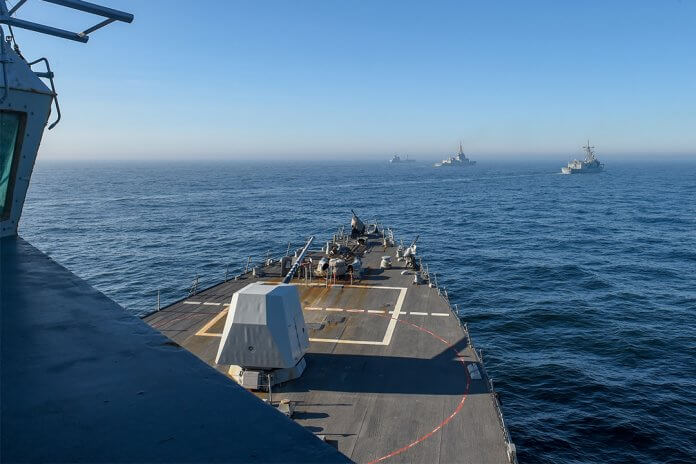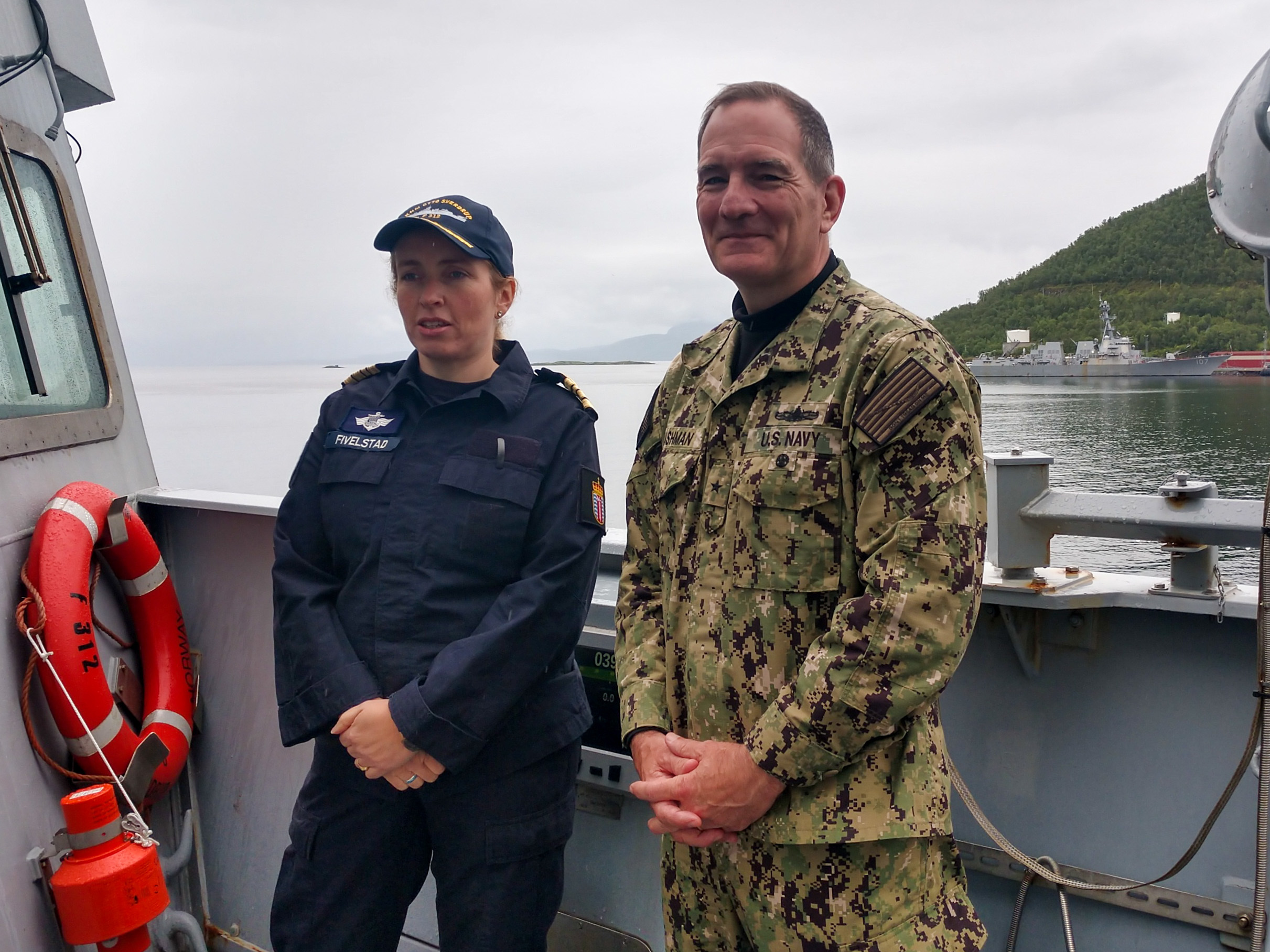
Exercise Dynamic Mongoose strengthens anti-submarine warfare skills and wider trans-Atlantic naval team building.
The strategic, operational, and technological impact of the return of state-based naval rivalry in the Euro-Atlantic theatre is perhaps nowhere more acutely evident than in the underwater domain.
Submarines have always been regarded as enabling their operator to deliver a ‘bigger bang for the buck’. Australian analyst Andrew Davies has argued that possession of a submarine enables the navy and the country concerned to “jump the queue” in terms of developing strategic influence.
So it was that a return of submarine activity across the Euro-Atlantic theatre – from the high North to the Eastern Mediterranean – was one of the first and most prominent military manifestations of Russia’s return to the world stage from 2008. Across the Euro-Atlantic region, Russian boats have become increasingly active in projecting power at sea and ashore and generating presence likely intended to reduce NATO naval freedom of manoeuvre or even to deny the alliance access to particular waters.
Consequently, a high-end NATO exercise in the North Atlantic such as the recent Dynamic Mongoose anti-submarine warfare (ASW) exercise is a significant tool in the alliance’s toolkit for reassuring regional allies and partners and deterring Russian activity, as well as re-building core ASW skills and capabilities.
Underlining another significant factor in the current strategic balance – the increasing presence of US Navy (USN) assets in North Atlantic waters once again – Dynamic Mongoose was based around Standing NATO Maritime Group 1 (SNMG1), with the group led by the USN.
As NATO seeks to rebuild capacity in core capability areas such as ASW through exercises, while concurrently maintaining presence to provide influence in the ‘real world’ of operations, running a major ASW exercise in the North Atlantic reinforced to exercise commanders the essence of the alliance.
“As I speak to people on the importance of the alliance and the connections, I remind them that the alliance itself isn’t named after a nation or a body of land or a place where a people live: it’s named after the North Atlantic; it’s named after that bridge that connects the continents and the [countries] and the members of the alliance,” Rear Admiral Edward Cashman, Commander SNMG1, told Armada.
Talking to Armada from SNMG1 flagship USS Gravely (an Arleigh Burke-class guided-missile destroyer) during the exercise, RAdm Cashman said “A navy’s role is to maintain that bridge and maintain the freedom of movement and the security of that connection. So the North Atlantic itself is by definition a strategic waterspace that we need to be able to operate in, and we need to be able to assure allies and deter potential adversaries.”

SNMG1 Assembles
For the exercise – held off the Norwegian coast in early July – Gravely was joined by two UK Royal Navy (RN) Type 23 towed-array sonar-capable frigates, HM Ships Sutherland and Westminster, the Royal Danish Navy’s Iver Huitfeldt-class frigate HDMS Peter Willemoes, the Royal Norwegian Navy’s Fridtjof Nansen-class frigate HNoMS Otto Sverdrup, and the Turkish Naval Forces Command’s Gabya-class frigate TCG Gokova. Together, these platforms brought three Sikorsky MH-60 Romeo, one Leonardo EH-101 Merlin, one Lynx, and one SH-70 Seahawk helicopter in their organic air ‘orbat’. Two more Merlins also joined the exercise, operating in the maritime patrol role.
The helicopters were joined in the air by two USN Boeing P-8A Poseidon, two Royal Canadian Air Force Lockheed CP-140 Aurora, two French Breguet Atlantique, and three Boeing P-3 Orion maritime patrol aircraft (MPAs).
Below the surface, the ASW threat came from four submarines, provided by France, Norway, the United Kingdom, and the United States.

Subsurface Threat
The importance of exercises like Dynamic Manta in providing a trans-Atlantic bridge in terms of training, capabilities, and operations is underlined by the level of sub-surface threat in the North Atlantic. The submarine presence on the exercise demonstrated the extent of the problem for naval commanders in the North Atlantic, with the three submarines exploiting the advantages of the deep, cold waters off Norway and Norway’s own boat using its deep knowledge of Norway’s fjords and other littoral regions to provide the shallow-water threat.
These two challenges provided a combined threat, said Rear Adm Cashman. Submarines operating in deep water or shallower, more constrained waters present different ASW challenges for surface ships and aircraft, he continued, adding “that’s why it’s important to continue to stress all of those different environments”.
Reflecting the focus across NATO on building exercises that add a greater level of complexity to training, RAdm Cashman said the exercise design and planning for Dynamic Mongoose had enabled participating assets to maximise operational benefit in terms of understanding the operating environment, especially below the surface. “The challenge for us at the task group level and for the aircraft – and for the submarines, frankly, as well – is to assess and evaluate their operating area – the water column, the temperature at depth, what the sound is going to do in various areas, what the non-acoustic detection possibilities could be – and design a set of capabilities and how to employ them to achieve their objectives.” One such objective, he added, is “understanding the adversary and how the submarines are likely to use that environment to their advantage”. A particular new capability that may address this is the USN’s P-8A MPA.

Alongside the other MPAs present, RAdm Cashman pointed to the P-8A’s speed, reach, and ability to create stand-off capability in a submarine operating area. “Their endurance [and] their length of time on station is invaluable,” he said. “To go out [and] find, track, either sanitise an area, put up a barrier, [or] make sure no-one is in an area we’re headed to next, there’s various tactics and techniques they can employ,” the admiral continued. “The capabilities are pretty special.”
Norway and the UK are also investing in a P-8A capability, and the three countries are working closely together on basing, logistics, maintenance, and operational concepts to maximise coverage across what is a very busy submarine operating environment in the Euro-Atlantic theatre.
Broadly, the purpose of an exercise like Dynamic Mongoose is to provide complex, advanced, multi-unit operational training in a relevant operational environment.
In the search for submarines, the exercise’s serials covered events using surface ships, aircraft, or surface ships and aircraft combined. Missions for the task group included protecting a high-value unit or convoy in transit between two points, or sanitising a particular area.
RAdm Cashman said the scenarios and serials were designed very well to help the assembled forces achieve the training and wider operational objectives. “The operating area, the number of forces, four different submarines …, MPAs, and helos enabled us to really fuse air and surface operations together, and I think the exercise design enabled us to really test our ability to understand the environment and to design a plan to execute event by event,” the admiral explained.
Mix of Capabilities
Regarding the combination of capabilities an SNMG brings and the impact it has on such an exercise, “the critical thing is to have the right mix of capabilities”, said Rear Adm Cashman, with such capabilities including both platforms and people. “To have hull-mounted sonars operating in various frequencies and levels, to have towed array variable-depth sonars, to have embarked helos … but also controllers and the ability to work with MPAs that will flow in from the outside” all combine to bring this right mix of capabilities in the exercise. “The units themselves bring whatever they’ve been nationally fitted with,” the admiral explained, with these capabilities “[playing] different roles depending on the mission and the water-space and the potential adversary”. On top of this, he continued, “it’s really [the] communications, the command and control (C2), the data links, and the procedures to be able to integrate units [that] is the core capability the group brings.”
While noting that exercises such as Dynamic Mongoose often validate the experience and best practice established over time, rather than necessarily exposing any new lessons, he said there remains much value in such validation, particularly in training the people.
“From the sonar operators, the aircraft commanders and pilots, the sensor operators, the ASW evaluation teams, the principal warfare officers (PWOs), and decision-makers. That’s a never-ending process,” he explained. “People grow and evolve, people change jobs, so the need to continue to train and work together and integrate the people, the way that they communicate and the way that they operate, is really critical. That experience set is one of the critical things we build when we do these exercises.”
With those PWOs set to become commanding officers in the future, the commanding officers to become squadron or task group commanders, and the sensor operators needing to pass on the experience to those who follow them, “it’s the training and the continuity of the people involved that I see as one of the critical values of these exercises”, said Rear Adm Cashman.
Set against concerns in some quarters that the post-Cold War years of NATO maritime operational focus on lower-end maritime security tasks to support expeditionary operations at distance had seen core naval war fighting skills such as ASW atrophy, Rear Adm Cashman argued that the returning focus on ASW in exercises like Dynamic Mongoose and Dynamic Manta (the alliance’s Mediterranean ASW exercise) are seeing NATO’s navies re-generate and maintain the required expertise. This has been enabled, he said, by the alliance’s well-established communications, datalink, and common operating procedures. “I’ve been incredibly impressed by the readiness, by the experience, of the operators across the force. The non-commissioned officers (NCOs) and the PWOs across the NATO nations are incredibly well trained, experienced, and interoperable. They know NATO procedures and NATO doctrine, and they’re able to integrate quickly, form a unit based on the forces that are available, and almost immediately start operating together.”
“An exercise like Dynamic Mongoose proves the ability for the core of the SNMG to take additional forces, … integrate them quickly based on common doctrine, common understanding, and well-established NATO interoperability, [and] to scale the force to what we need for the mission,” the admiral added.
With its own increasing presence, the USN also is re-growing the experience of its own personnel in operating in the region. Alongside bringing highly capable platforms into play, including new capabilities like the P-8, RAdm Cashman said USN personnel are also benefiting from working with allies and partners from countries across the North Atlantic region. “The regional expertise is invaluable, and the USN units learn a lot whenever we come over, and it’s great professional development and training experience for everyone from folks like me all the way down to [the sailors] sitting in sonar and operating on the plot.”
The importance of that established experience amongst sailors themselves also relates to the alliance as a whole. While the numbers of platforms in an SNMG may change as ships ‘chop in’ and ‘chop out’ of the group over time, an SNMG’s task group staff exists “24/7, 365”, said RAdm Cashman; “the staff, the procedures, and the ability to conduct C2 of that operation is continuous.” As a result, he continued, an SNMG can “build and maintain readiness on a continual basis, to be able to respond if there’s a crisis or conflict, primarily … to deter any sort of actions”.












